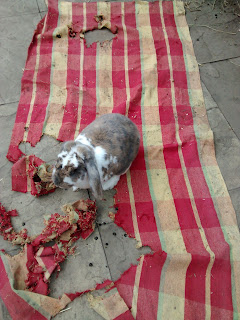After a sticky 20 minutes spent fighting my way past sawdust, hay bales, bikes and a million almost-empty cans of paint, I finally spotted the edge of the hammock rolled up at the back of the shed.
Unfortunately for my afternoon plans, when I unrolled the hammock became clear I was not the first to fancy spending a bit of time in it. Moreover, the unknown critter had enjoyed their hammock experience so much that they had decided to take a large part it back with them to their nest. It was a sorry sight, with a huge chunk of one corner missing and a hole the size of my head at the other end. I could have worn it as a tabard, but it was no longer any use as a hammock.
 |
| The devastation, with Charles for scale, although he's doing a good job of looking guilty. |
As far as I could tell the body of the hammock had constructed as follows. Loops had been made in the fabric at each end of the hammock body. These were formed by making 3 inch cuts into the material along each end; these flaps were folded in half and stitched to the back of the fabric under a cover strip. The hanging ropes had been fed through these loops and each rope passed through a hole in a spreader bar - a strip of wood at each end to hold the fabric open. It was clear to me that it was going to be difficult to use a completely new piece of fabric for the hammock without undoing the entire structure, ropes, bars and all. However, as there was an intact strip of hammock fabric adjacent to each of the spreading bars (below), I decided that it would be far easier to just sew a new rectangle of fabric directly to these.
The down-side of this plan was that I would have to feed a piece of fabric through my sewing machine that was attached to a large strip of wood. It was for this reason that I spent the remainder of the afternoon in the increasing gloom of our house. Sewing the new material to the remnants of the old hammock was difficult and slow. I used a double-thickness of replacement fabric to provide extra strength and managed to shear two sewing machine needles trying to sew this to the thick fabric of the original hammock.
I have added a new hook to the shed so that I can store my lovely 'new' hammock up off the floor, and I'm also planning on rolling it in a bin bag for extra anti-furry-creature security. I may also move the rat poison nearer as a warning.
Unfortunately since repairing the hammock it has rained pretty much constantly while I've been home!



No comments:
Post a Comment